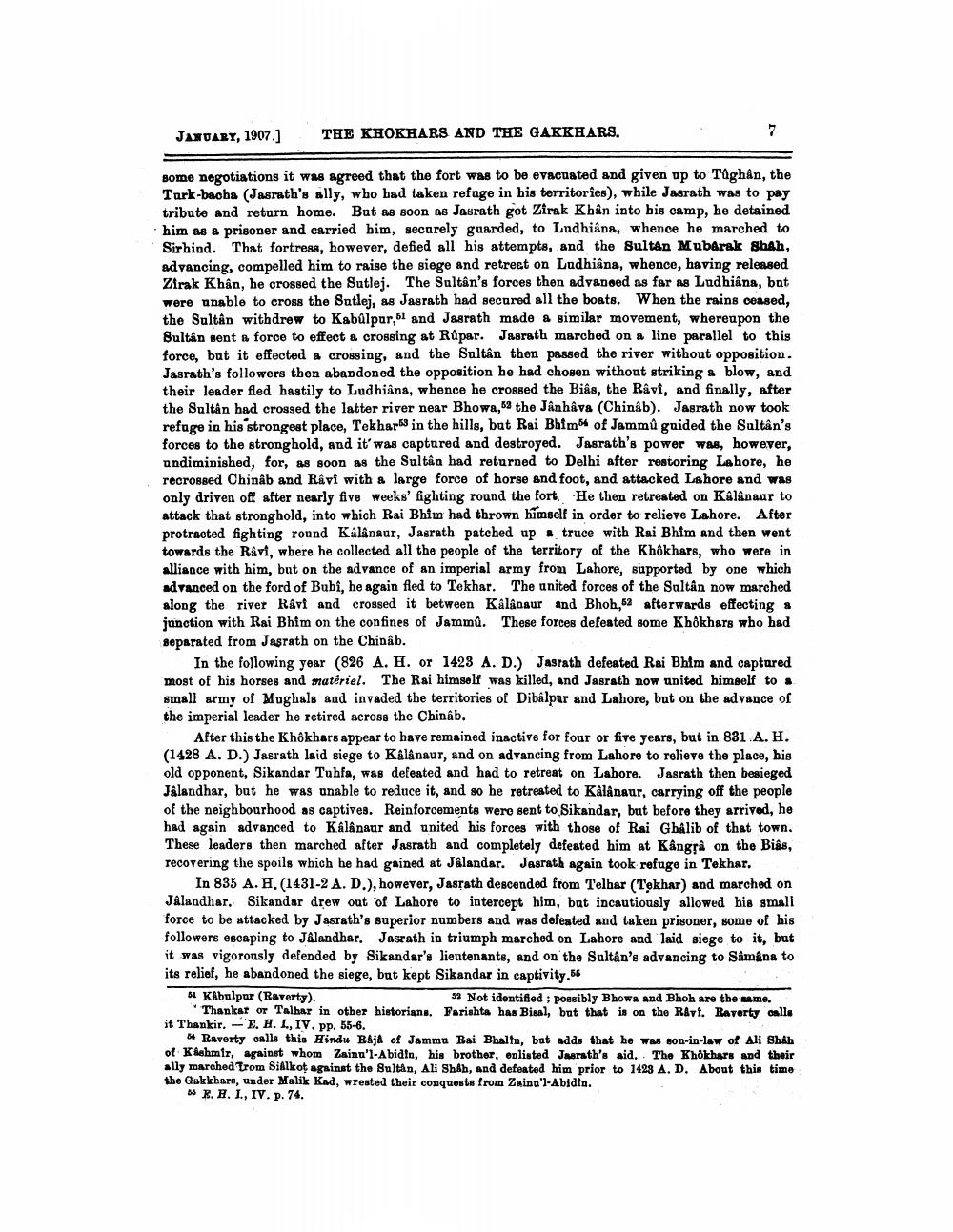________________
JANUARY, 1907.]
THE KHOKHARS AND THE GAKKHARS.
some negotiations it was agreed that the fort was to be evacuated and given up to Tūghân, the Turk-baoba (Jasrath's ally, who had taken refage in his territories), while Jasrath was to pay tribute and return home. But as soon as Jasrath got Zirak Khân into his camp, he detained him as a prisoner and carried him, securely guarded, to Ludhiana, whence he marched to Sirhind. That fortress, however, defied all his attempts, and the Sultan Mubarak Shah, advancing, compelled him to raise the siege and retreat on Ludhiana, whence, having released Zirak Khân, he crossed the Sutlej. The Sultân's forces then advaneed as far as Ludhiâna, bat were unable to cross the Sutlej, as Jagrath had secured all the boats. When the rains ceased, the Sultan withdrew to Kabúlpur, 51 and Jasrath made a similar movement, whereupon the Sultân sent a force to effect a crossing at Rûpar. Jasrath marched on a line parallel to this force, but it effected a crossing, and the Sultân then passed the river without opposition. Jasrath's followers then abandoned the opposition he had chosen without striking a blow, and their leader fled hastily to Ludhiana, whence he crossed the Biâs, the Ravi, and finally, after the Sultân bad crossed the latter river near Bhowa,62 the Jânhiva (Chinâb). Jagrath now took refuge in his strongest place, Tekharks in the hills, bat Rai Bhim of Jammu guided the Sultan's forces to the stronghold, and it' was captured and destroyed. Jasrath's power was, however, undiminished, for, as soon as the Sultân had returned to Delhi after restoring Lahore, he recrossed Chinâb and Ravi with a large force of horse and foot, and attacked Lahore and was only driven off after nearly five weeks' fighting round the fort. He then retreated on Kalânaar to attack that stronghold, into which Rai Bhim had thrown himself in order to relieve Lahore. After protracted fighting round Kalanaur, Jasrath patched up truce with Rai Bhim and then went towards the Ravi, where he collected all the people of the territory of the Khokhars, who were in alliance with him, but on the advance of an imperial army from Lahore, supported by one which advanced on the ford of Bubi, he again fled to Tekhar. The united forces of the Sultan now marched along the river Ravi and crossed it between Kâlânaur and Bhoh,62 afterwards effecting a junction with Rai Bhim on the confines of Jammů. These forces defeated some Khokhars who had separated from Jasrath on the Chinâb.
In the following year (826 A. H. or 1423 A. D.) Jagrath defeated Rai Bhim and captured most of his horses and matériel. The Rai himself was killed, and Jasrath now united himself to s small army of Mughals and invaded the territories of Dibalpur and Lahore, but on the advance of the imperial leader he retired across the Chinab.
After this the Khokhars appear to have remained inactive for four or five years, but in 831 A.H. (1428 A. D.) Jasrath laid siege to Kalânaur, and on advancing from Lahore to relieve the place, bis old opponent, Sikandar Tuhfa, was defeated and had to retreat on Lahore. Jasrath then besieged Jalandhar, but he was unable to reduce it, and so he retreated to Kâlânaur, carrying off the people of the neighbourhood as captives. Reinforcements were sent to Sikandar, but before they arrived, he had again advanced to Kálênaur and united his forces with those of Rai Ghalib of that town. These leaders then marched after Jasrath and completely defeated him at Kângra on the Biâs, recovering the spoils which he had gained at Jalandar. Jasrath again took refuge in Tekhar.
In 835 A. H.(1431-2 A. D.), however, Jasrath descended from Telbar (Tekhar) and marched on JÄlandhar. Sikandar drew out of Lahore to intercept him, but incautiously allowed his small force to be attacked by Jasrath's superior numbers and was defeated and taken prisoner, some of his followers escaping to JÄlandhar. Jasrath in triumph marched on Lahore and laid siege to it, but it was vigorously defended by Sikandar's lieutenants, and on the Sultan's advancing to Samâna to its relief, he abandoned the siege, but kept Sikandar in captivity.56 61 Kabulpar (Raverty).
52 Not identified; possibly Bhowa and Bhoh are the mme. Thankar or Talhar in other historians. Farishta has Bisal, but that is on the R&vt. Ravorty calle it Thankir. - E. H. L, IV. pp. 55-6.
Ravorty calls this Hindu RAJA of Jammu Rai Bhaltn, but adds that he was son-in-law of Ali Shah of Klehmir, against whom Zainu'l-Abidin, his brother, onlisted Jasrath's aid. The Khokhars and their ally marched Trom Sialkot against the Sultan, Ali Shah, and defeated him prior to 1428 A. D. About this time the Gakkbars, under Malik Kad, wrested their conquests from Zsinu'l-Abidin.
66 E. H. I., IV. p. 74.




